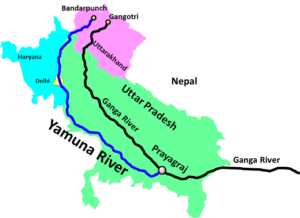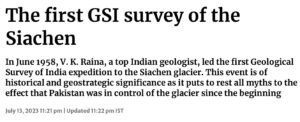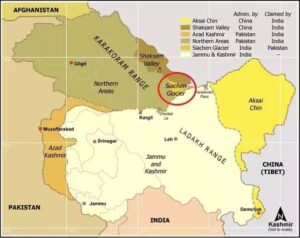India-France Relations
GS 2: Bilateral, regional and global groupings and agreements involving India and/or affecting India’s interests.
Effect of policies and politics of developed and developing countries on India’s interests, Indian diaspora.

Introduction
- India and France have a long history of friendly and strategic partnership, dating back to the colonial times when French traders came to India to establish commercial relations.
- The two countries share common values of democracy, rule of law, human rights, and multilateralism, and have a high degree of convergence on a range of regional and global issues.
- The areas of defence cooperation, space cooperation and civil nuclear cooperation constitute the three principal pillars of the strategic partnership, which was signed in 1998.
- Apart from these traditional fields of cooperation, India and France are increasingly engaged in new areas of cooperation such as climate change, sustainable growth and development, the International Solar Alliance, maritime security in the Indo-Pacific region, counter-terrorism, cyber security and digital technologies.
Defence Cooperation
- Defence cooperation is one of the key aspects of the strategic partnership, as both countries face common security challenges and threats.
- The two countries have regular exchanges of visits at the level of services chiefs, defence ministers and secretaries, and national security advisors.
- The two countries also conduct joint military exercises such as Exercise Shakti (Army), Exercise Varuna (Navy), and Exercise Garuda (Air Force), which enhance interoperability and mutual understanding between the forces.
- The two countries have also signed several agreements and MoUs on defence-related matters, such as
- the Agreement for the provision of reciprocal logistics support between their armed forces (2018),
- the Agreement on Exchange and Reciprocal Protection of Classified or Protected Information (2018),
- the Agreement on Defence Cooperation (2006),
- the Agreement on Transfer of Defence Technology (2006).
- The most prominent defence project between the two countries is the purchase of 36 Rafale fighter jets by India from France, which is expected to boost India’s air power and deterrence capabilities.
Space Cooperation
- Space cooperation is another important pillar of the strategic partnership, as both countries have advanced capabilities and expertise in this domain.
- The two countries have been cooperating in space since 1964, when France helped India launch its first sounding rocket from Thumba Equatorial Rocket Launching Station (TERLS).
- The two countries have jointly developed and launched several satellites for various purposes such as remote sensing, meteorology, communications, astronomy, etc. Some examples are Megha-Tropiques (2011), SARAL (2013), ASTROSAT (2015), etc.
- The two countries have also signed several agreements and MoUs on space-related matters, such as the Joint Vision for Space Cooperation (2018), the Agreement on Cooperation in the Exploration and Use of Outer Space for Peaceful Purposes (2008), the Agreement on Satellite Navigation (2004), etc.
- The most recent space project between the two countries is the cooperation on Gaganyaan mission, India’s first manned space flight programme. France’s space agency CNES will provide technical assistance, training, equipment and medical instruments for Indian astronauts.
Civil Nuclear Cooperation
- Civil nuclear cooperation is another key area of the strategic partnership, as both countries have a common interest in developing clean and sustainable energy sources.
- The two countries signed a bilateral civil nuclear cooperation agreement in 2008, which paved the way for collaboration in various aspects such as nuclear power generation, research and development, safety and security, waste management, etc.
- The most significant civil nuclear project between the two countries is the construction of six EPR reactors at Jaitapur in Maharashtra by French company EDF.
- The project is expected to be one of the largest nuclear power plants in the world with a capacity of 9.6 GW.
- Countries have also signed several agreements and MoUs on civil nuclear-related matters, such as
- the Industrial Way Forward Agreement (2018),
- the Agreement on Nuclear Liability (2010),
- the Agreement on Nuclear Safety (2009), etc.
New Areas of Cooperation
- Apart from the traditional fields of cooperation, India and France are also exploring new areas of cooperation that reflect their shared vision and interests in addressing global challenges and opportunities.
- One such area is climate change , where both countries have shown leadership and commitment to implement the Paris Agreement and promote low-carbon development. The two countries launched the International Solar Alliance (ISA) in 2015, a global initiative to mobilize resources and technology for solar energy deployment in developing countries.
- The ISA has now 121 member countries and has undertaken several projects and programmes to promote solar energy.
- Another area is sustainable growth and development , where both countries have agreed to enhance cooperation in sectors such as urban development, smart cities, renewable energy, water management, waste management, etc.
- The two countries have also established a bilateral development partnership fund to support projects in third countries in Africa and Asia.
- A third area is maritime security in the Indo-Pacific region , where both countries have a common interest in maintaining peace, stability and freedom of navigation and overflight.
- The two countries issued a Joint Strategic Vision of India-France Cooperation in the Indian Ocean Region in 2018, which outlines the areas of cooperation such as maritime domain awareness, capacity building, humanitarian assistance and disaster relief, joint exercises, etc.
- The two countries have also established a bilateral maritime security dialogue to coordinate their actions and policies in the region.
- A fourth area is counter-terrorism , where both countries have faced the scourge of terrorism and have resolved to work together to combat this menace.
- The two countries have a Joint Working Group on Counter Terrorism, which meets regularly to exchange information, intelligence and best practices.
- The two countries have also signed several agreements and MoUs on counter-terrorism-related matters, such as
- the Agreement on Mutual Legal Assistance in Criminal Matters (2005),
- the Agreement on Extradition (2003),
- the Agreement on Combating Illicit Trafficking
- Consumption of Narcotic Drugs (1997), etc.
- A fifth area is cyber security and digital technologies , where both countries have recognized the potential and challenges of the digital revolution and have agreed to cooperate in areas such as cyber security, data protection, artificial intelligence, digital innovation, etc.
- The two countries issued a India-France Roadmap on Cybersecurity and Digital Technologies in 2019, which outlines the areas of cooperation such as cyber security policy, cyber defence, cyber crime, cyber resilience, data governance, digital economy, etc.
Conclusion
- India and France have a strong and multifaceted strategic partnership that is based on shared values, interests and vision.
- The two countries have cooperated extensively in various fields such as defence, space, civil nuclear, climate change, sustainable development, maritime security, counter-terrorism, cyber security and digital technologies.
- The two countries have also supported each other’s aspirations and positions in regional and global forums such as the UN, G20, EU, etc.
- The two countries have immense potential to further enhance their cooperation and partnership in the emerging areas of mutual interest and benefit.
Yamuna River
GS 1: Important Geophysical phenomena such as earthquakes, Tsunami, Volcanic activity, cyclone etc., geographical features and their location-changes in critical geographical features (including water-bodies and ice-caps) and in flora and fauna and the effects of such changes.
GS 3 : Disaster and disaster management.


- Geographical Features:
Source:
- The Yamuna originates from the Yamunotri Glacier, located in the Uttarkashi district of Uttarakhand, at an altitude of around 6,387 meters (20,955 feet) in the Garhwal Himalayas.
Course:
- The river flows a total distance of approximately 1,376 kilometers (855 miles) through the states of Uttarakhand, Himachal Pradesh, Haryana, Delhi, and Uttar Pradesh.
Tributaries:
- Some of the important tributaries of the Yamuna include the Tons, Chambal, Sindh, Betwa, and Ken rivers.
Confluence:
- The Yamuna meets the Ganges at Prayagraj, forming a confluence known as the Triveni Sangam.
- Significance and Cultural Importance:
Mythological Importance:
- The river is named after the sister of Yama, the god of death, and the daughter of Surya, the sun god.
- According to Hindu legends, the river was born from the tears of Hanuman, the monkey god, when he was flying to bring the Sanjeevani herb to save Lakshmana, the brother of Rama.
- The river is associated with Lord Krishna, who spent his childhood and youth in the region of Vrindavan on the banks of the Yamuna.
- The river is also a site of pilgrimage and festivals, such as Kumbh Mela, Chhath Puja, Yamuna Jayanti, and Brij Mahotsav.
- Devotees believe that bathing in the river can free them from the cycle of death and rebirth.
Historical Heritage:
- Several ancient cities and historical sites are located along the banks of the Yamuna, including Delhi, Agra (home to the iconic Taj Mahal), Mathura, and Vrindavan.
Economic Importance of River Yamuna:
- The river is a vital source of water for irrigation, drinking, and industrial use for millions of people living in its basin.
- The river also supports agriculture, fisheries, tourism, and hydroelectric power generation.
- The river has two major canals:
- the Western Yamuna Canal and
- the Eastern Yamuna Canal, which divert water for various purposes.
- The river also contributes to the formation of the fertile Ganges-Yamuna Doab region between itself and the Ganges.
Hydropower projects
Yamuna Hydroelectric Project: This project is located in Uttarakhand and has an installed capacity of 474.75 MW. It was completed in 1975.
Lakhwar-Vyasi Hydroelectric Project: This project is located in Uttarakhand and has an installed capacity of 420 MW. The first phase of the project, the Vyasi Hydroelectric Project, was completed in 2022.
The second phase, the Lakhwar Hydroelectric Project, is currently under construction.
Environmental Challenges:
- Pollution:
- The Yamuna faces severe pollution issues, primarily due to untreated sewage, industrial effluents, and agricultural runoff.
- The pollution levels have a detrimental impact on the river’s ecosystem and the health of people dependent on its water.
- Drying and Water Scarcity:
- The river often suffers from reduced flow and drying stretches, particularly during the summer months.
- Over-extraction of water, climate change, and human activities contribute to the diminishing water levels.
- Biodiversity Loss:
- The ecological balance of the river is under threat due to pollution and habitat degradation.
- The decline in water quality negatively affects aquatic species, including the endangered Gangetic dolphin.
Conservation Efforts:
Yamuna Action Plan:
- The Government of India initiated the Yamuna Action Plan to address pollution and improve the river’s water quality.
- It involves various measures such as sewage treatment plants, afforestation, and public awareness campaigns.
Riverfront Development Projects:
- Several cities along the Yamuna are undertaking riverfront development projects to rejuvenate the river and create green spaces. These projects aim to integrate ecological conservation and recreational activities.
Legal Interventions:
- The National Green Tribunal and other judicial bodies have intervened to monitor and enforce measures for the protection and restoration of the Yamuna’s ecosystem.
Siachen Glaciers
GS 1 :Important Geophysical phenomena such as earthquakes, Tsunami, Volcanic activity, cyclone etc., geographical features and their location-changes in critical geographical features (including water-bodies and ice-caps) and in flora and fauna and the effects of such changes.
GS 3 :Conservation, environmental pollution and degradation, environmental impact assessment.


Introduction
- The Siachen Glacier is a glacier located in the eastern Karakoram range in the Himalayas, just northeast of the point NJ9842 where the Line of Control between India and Pakistan ends.
- It is the second-longest glacier in the world outside the polar regions, and is the highest battlefield in the world.
Geography
- The Siachen Glacier is about 76 kilometers (47 miles) long and up to 5 kilometers (3.1 miles) wide.
- It is located at an altitude of over 6,000 meters (20,000 feet).
- The glacier is fed by snowmelt from the surrounding mountains, and it drains into the Nubra River.
History
- The Siachen Glacier was first explored by the British in the 19th century.
- However, it was not until the 1980s that the Indian Army established a presence on the glacier.
- The Indian Army’s presence on the glacier was in response to the Pakistani Army’s construction of a road along the Saltoro Ridge, which overlooks the glacier.
Significance of Siachen
- Strategic Importance:
- The Siachen Glacier is located near the trijunction of India, Pakistan, and China, and overlooks the strategic Karakoram Pass that connects China and Pakistan.
- It also provides access to the Shaksgam Valley, which was ceded by Pakistan to China in 1963.
- Controlling the glacier gives India an advantage in monitoring the movements and activities of its rivals along the Line of Control (LoC) and the Line of Actual Control (LAC).
- The glacier also acts as a buffer zone between India and Pakistan, preventing any direct confrontation or escalation of hostilities
- Water Resource:
- The Siachen Glacier is an important source of water for the Indus River system, which supports irrigation, drinking, and hydropower generation for millions of people in India and Pakistan.
- The glacier is also home to a unique and diverse ecosystem, including rare and endangered species such as the snow leopard and the Himalayan ibex.
- The glacier is considered to be the largest single source of fresh water on the Indian subcontinent.
- Scientific Value:
- The Siachen Glacier offers a valuable opportunity for scientific research and exploration in various fields, such as glaciology, climatology, geology, biology, and astronomy.
- The glacier is a natural laboratory for studying the effects of climate change, glacial dynamics, and biodiversity conservation.
- The glacier also provides a challenging environment for testing new technologies and equipment for high-altitude warfare and survival.
- The glacier has been visited by several scientific expeditions from India and other countries over the years.
Environmental Issues
- The Siachen Glacier is facing a severe environmental crisis due to human activities and climate change.
- The presence of military forces on both sides has led to pollution, deforestation, habitat loss, and biodiversity loss in the region.
- The dumping of solid waste, such as plastics, metals, chemicals, and ammunition, on the glacier has contaminated the water sources and threatened aquatic life.
- The use of fossil fuels for heating and transportation has increased greenhouse gas emissions and contributed to global warming.
- The melting of glaciers due to rising temperatures has increased the risk of floods, landslides, and glacial lake outburst floods (GLOFs) in downstream areas.
- The Siachen Glacier is one of the most fragile ecosystems in the world. The glacier is melting at an alarming rate, and this is causing a number of environmental problems.
Glacier retreat: The Siachen Glacier is retreating at an average rate of 10 meters (33 feet) per year. This is causing the Nubra River to become more unpredictable, and is also leading to the loss of habitat for a number of endangered species.
- Satellite images indicate that the glacier is melting away by 110 metres a year and the glacier size decreased by 35%
- Water pollution: The melting glacier is also causing water pollution. The melting glacier is carrying a lot of sediment, and this sediment is entering the Nubra River.
This is making the water in the river cloudy and undrinkable.
- Flora and Fauna The region is also home to rare and endangered species, such as snow leopards, brown bears, ibexes, and golden eagles, which are at risk due to habitat fragmentation and poaching
- Landslides: The melting glacier is also causing landslides. These landslides are a major danger to both soldiers and civilians.
Wayforward
- Reducing the military presence and activities in the region, which contribute to the glacial retreat, waste dumping, and loss of biodiversity.
- This would require a political agreement between India and Pakistan to demilitarize the region and resolve the border dispute peacefully.
- Implementing a cleanup campaign to clear the region of biodegradable and non-biodegradable wastes, such as plastics, metals, and human excreta, which pollute the glacier and its surroundings.
- One possible solution to the immediate problem of garbage in Siachen is to use microbiology-based solutions to decompose it.
- Declaring the Siachen glacier as a peace park or a world heritage site, where both countries can cooperate on scientific research and environmental conservation.
This would help preserve the natural beauty and ecological diversity of the region, as well as promote tourism and cultural exchange.
Duchenne Muscular Dystrophy
GS 2: Issues relating to development and management of Social Sector/Services relating to Health, Education, Human Resources.
GS 3 :Awareness in the fields of IT, Space, Computers, robotics, Nano-technology, bio-technology and issues relating to intellectual property rights.
Overview
- Duchenne muscular dystrophy (DMD) is a genetic disorder that causes progressive muscle degeneration and weakness.
- It is the most common form of muscular dystrophy, affecting about 1 in 3,500 boys worldwide.
- DMD is caused by a mutation in the DMD gene, which codes for the protein dystrophin.
- Dystrophin is essential for the structural integrity of muscle cells, and its absence leads to muscle weakness and eventual death of the muscle cells.
Signs and symptoms

- The symptoms of DMD typically begin in early childhood, between the ages of 2 and 5 years.
- The first signs may include:
* Difficulty walking
* Frequent falls
* Gower’s sign (a characteristic way of rising from a
sitting position)
* Enlarged calves
* Waddling gait
- As the disease progresses, muscle weakness and wasting spread to other parts of the body, including the arms, trunk, and respiratory muscles.
- In later stages of the disease, people with DMD may experience:
* Heart problems
* Breathing problems
* Scoliosis (curvature of the spine)
* Intellectual disability
Diagnosis
- DMD is diagnosed based on a combination of clinical features, genetic testing, and muscle biopsy.
- There is no cure for DMD, but there are treatments available that can help to slow the progression of the disease and improve quality of life.
Treatment
- There is no cure for DMD, but there are treatments available that can help to slow the progression of the disease and improve quality of life.
These treatments include:
- Physical therapy
- Occupational therapy
- Speech therapy
- Medications to help with muscle weakness and pain
- Gene therapy
- Prognosis
The life expectancy of people with DMD has increased in recent years, but most people with the disease do not live past their 30s.
The cause of death in people with DMD is usually respiratory failure.
Current research
- There is active research into treatments for DMD, including gene therapy and stem cell therapy.
- Gene therapy is a promising approach that could potentially cure DMD by replacing the defective DMD gene with a healthy copy.
Stem cell therapy is another promising approach that could potentially repair or replace damaged muscle cells.

